Welcome to my blog. My goal for the blog is to provide a venue for sharing information, photos, and stories related to wildlife species behavior, biology, and life history. Additionally, I hope to provide information related to wildlife photography techniques and issues from time to time.
Enjoy.
Ecuador 2025 Part 1
For clarification, due to Zenfolio's restrictions on blog size I had to break this blog into four parts. This is Part 1.
With over 1,600 species of birds, Ecuador is one richest countries in the world when it comes to bird diversity. Ecuador has over twice as many species as the US and Canada combined. Ecuador also boast the ecotourism infrastructure to support birders and bird photographers. Many small ecolodges and tour companies are present throughout the country.
The tour we selected arranged a private guide/driver for the Andean portion of the trip and a dedicated guide and assistant guide for our time in the Amazon. We arranged our tour through Aratinga Tours.
February 3
Direct flights from San Francisco to Ecuador are difficult to find and quite expensive. We flew from San Francisco to Atlanta, and then Atlanta to Quito, Ecuador. We were met at the modern Quito Airport by Luis Panama, our guide for the Andes portion of our tour. Luis is an excellent birder and, perhaps more importantly for me, he is also an accomplished photographer. He transported Becky and I to an airport hotel/resort where we had booked an extra night prior to the beginning of our tour.
February 4
I wandered the hotel grounds the next day in an attempt to adjust to the elevation. Quito is around 9,400 feet elevation and even moderate exertion left us gasping for air. The resort has four free-roaming llama which keep the lawn trimmed nicely. I managed to photograph a number of common Andean species including eared dove, sparkling violetear, and great thrush in the resort gardens. Less common species included black-tailed trainbearer, saffron finch, rufous-collared sparrow, vermillion flycatcher, black vulture, southern beardless tyrannulet, tropical mockingbird, and rusty flowerpiercer.

 Eared Dove
Eared Dove


Black-Tailed Trainbearer

 Saffron Finch
Saffron Finch


Vermillion Flycatcher
February 5
Luis picked us up early in the morning in his SUV. We spent the next 1.5 hours transiting Quito and its suburbs. About 2 million people live in Quito which is the capital and second largest city in Ecuador.
Within a few miles we were grateful that we had not opted for a self-driving tour. Traffic was heavy and drivers were aggressive. Luis skillfully and calmly negotiated the traffic. At one point we entered the "traffic circle from hell" with 4 lanes of every driver for himself. We survived.
After leaving the city we exited onto a gravel road and traversed an area of lush highlands. The area had been largely deforested and was occupied by many small dairy farms.
Our first photography destination was Zuraloma Reserve at 10,200 feet elevation. This reserve is in the foothills of Pichincha Volcano adjacent to the Yanacocha Reserve.
We photographed an immature black-chested buzzard-eagle and a sapphire- vented puffleg (hummingbird) even before we arrived. A nice start.


Black-Chested Buzzard-Eagle


Saphire-Vented Puffleg
The reserve is known as one of the best locations to photograph equatorial and chestnut-naped antpittas. Antpitta's are generally difficult to observe or photograph as they prefer dense, dark, low vegetation.Both antpitta species have been trained to come to a feeding station on a schedule and readily pose while consuming earthworms placed for them.


Chestnut-Naped Antpitta

 Equatorial Antpitta
Equatorial Antpitta
I took many images of each antpitta species and then moved on to the fruit and sugar feeders. At least 10 species of hummingbird were present including black-tailed trainbearer, green-tailed trainbearer, tyrian metaltail, mountain velvetbreast, white-bellied woodstar, sparkling violetear, collared inca, buff-winged starfrontlet and the spectacular sword-billed hummingbird. The sword-billed hummingbird has the longest beak per body size of any bird.

 Sword-Billed Hummingbird
Sword-Billed Hummingbird
Three species of flowerpiercers (masked, black, and glossy) were present and attracted to the sugar feeders. Flowerpiercers are nectar feeders and utilize a short hooked bill tip to feed on flowers at their base.

 Masked Flowerpiercer
Masked Flowerpiercer
The fruit feeders were also active with scarlet-bellied mountain tanager, Andean guan, blue-capped tanager, yellow-breasted brushfinch, gray-browed brushfinch, and chestnut-capped brushfinch.

 Andean Guan
Andean Guan

 Red-Bellied Mountain Tanager
Red-Bellied Mountain Tanager
We hiked up a steep adjacent hillside in search of the striking ocellated tapaculo. Unlike the antpittas, the tapaculo failed to appear even after much calling by the local guides. Hills are steeper at 10,000 feet than at sea level.
We stopped for lunch at the Mirador Guay Cap. Excellent grilled steak and an incredible diversity of birds. The sugar feeders were set up within feet of our lunch table and the fruit feeders were not much further. It rained the entire time we were dining, however, the bird activity was constant and overwhelming. The patio area is covered so I was able to take hundreds of photos at very close range.
The fruit feeders attracted golden-olive woodpecker, rufous motmot, collared aracari, crimson-rumped toucanet, red-headed barbet, bananaquit, summer tanager, thick-billed euphonia, bay-headed tanager, blue-gray tanager, palm tanager, white-lined tanager, flame-rumped tanager, golden tanager, golden-naped tanager, and blue-necked tanager. Wow!

 Bay-Headed Tanager
Bay-Headed Tanager

 Black-Capped Tanager
Black-Capped Tanager

 Blue-Necked Tanager
Blue-Necked Tanager

 Collared Aracari
Collared Aracari

 Crimson-Rumped Toucanet
Crimson-Rumped Toucanet

 Golden Tanager
Golden Tanager


Red-Headed Barbet
Hummingbirds were also numerous as they battled for dominance at the feeders. I was able to photograph booted racket-tail, purple-throated woodstar, white-whiskered hermit, Andean emerald, white-necked jacobin, rufous-tailed hummingbird, green-crowned brilliant, and crowned woodnymph.

 Booted Racket-Tail
Booted Racket-Tail


Rufous-Tailed Hummingbird


Sparkling Violetear

 Luis Panama, Becky and I.
Luis Panama, Becky and I.
We left the restaurant in a heavy downpour and drove a short distance to our next west Andean lodge (Sachatamia Lodge). We choose to avoid the heavy afternoon rain and settle into our cozy cabin. We enjoyed a nice dinner at the lodge and were introduced to the local custom of adding popcorn to our soup. Better than it sounds.
Feb 6
We departed early for Refugio Aves de Paz. This refuge is a private nature reserve founded by Angel Paz in 2005. Angel pioneered the practice of training antpittas to come on a schedule to a call for earthworms. Five species of antpitta are present on the preserve. We were fortunate to photograph three antpitta species including the giant antpitta.

 Giant Antpitta
Giant Antpitta


Chestnut-Crowned Antpitta

 Yellow-Breasted Antpitta
Yellow-Breasted Antpitta
We photographed a number of species we had not previously seen in Ecuador including three-striped warbler, lyre-tailed nightjar, ornate flycatcher, toucan barbet, blue-winged mountain tanager, white-tipped dove, crested guan, flame-faced tanager, montane woodcreeper, rufous-breasted antthrush, giant antpitta, chestnut-crowned antpitta, yellow-breasted antpitta and smoky-brown woodpecker.

 Blue-Winged Mountain Tanager
Blue-Winged Mountain Tanager

 Toucan Barbet
Toucan Barbet

 Rufous-Breasted Antthrush
Rufous-Breasted Antthrush

 Flame-Faced Tanager
Flame-Faced Tanager
Additional hummingbird species included velvet-purple coronet, brown inca, brown violetear, purple-bibbed whitetip, empress brilliant and speckled hummingbird.

 Empress Brilliant
Empress Brilliant


Purple-Bibbed Whitetip
We were scheduled to also visit an Andean cock-of-the-rock lek on the reserve, however Luis opted to take us to an alternative location the next morning to photograph this amazing display.
While driving back to the lodge for lunch Luis spotted a golden-headed quetzal. I managed to get out along a busy highway and grab a few backlit shots of this fabulous trogon species.

 Golden-Headed Quetzal
Golden-Headed Quetzal
If it was raining or we were seeing little bird activity Luis always knew another good place. After lunch at Sachatamia Lodge it was once again raining. This is a weather pattern that occurred regularly with clear morning and rainy afternoons. After lunch Becky opted to rest at the resort while Luis and I drove about an hour to get to an elevation below the rain. We drove some backroads and picked up a few new species including a masked water tyrant, laughing falcon, roadside hawk, and collared forest falcon.


Collared Forest Falcon
We returned to the lodge where the rain continued. We picked up the now well rested Becky and dropped down to a lower elevation for a visit to the feeders at Sendero Family Tour (SFT). These feeders were excellent and we encountered and photographed many new species. In addition to the sugar and fruit feeders they also provided corn feeders.
At SFT we immediately spotted a hook-billed kite and a small flock of yellow-bellied siskin. The fruit feeders attracted lineated woodpeckers as well as black-cheeked woodpecker and golden-olive woodpecker. Other new species included black-winged saltator, buff-throated saltator, dusky-faced tanager, orange-billed sparrow, great antshrike, yellow-rumped cacique, red-billed scyebill, streak-headed woodcreeper, cinnamon becard, rusty margined flycatcher, and blue-black grassquit.


Hook-Billed Kite

 Great Antshrike
Great Antshrike

 Lineated Woodpecker
Lineated Woodpecker

 Black-Winged Saltator
Black-Winged Saltator
We also photographed a few new species of hummingbird including black-throated mango and long-billed starthroat. Pretty amazing day of photography.

 Black-Throated Mango
Black-Throated Mango


Green Thorntail
Feb 7
We left well before daylight to allow travel time to our next photo venue (La Victoriana). This location contains a large 15-60 bird lek of Andean cock-of-the-rock. We walked over an hour in the dark to reach the lek before daylight. As we approached the lek the noise of the displaying males was amazing. They sounded like the squealing of dozens of pigs. As the sky slightly lightened we began to see a dozen or more of the large beautiful coatingas calling and displaying. What a treat. Some were quite close and a few were even in open situations without intervening limbs. It was quite dark under the tree canopy. I was shooting at very high ISO and still had ridiculously low shutter speeds. I did ok on stationary birds, but had insufficient shutter speed to capture the wing flaps and side-shuffle dance of the display. These displays last around an hour. I never saw a female, but suspect a few may have been present based on the males behavior.

 Andean Cock-of-the-Rock
Andean Cock-of-the-Rock


Andean Cock-of-the-Rock
Luis shared how this venue had been developed. The owner/operator lost her job in Quito due to the pandemic and returned to the family farm. While out early one morning moving cows she happened upon the lek. She mentioned it to a local birding guide who encouraged her to develop the site. She cut over a mile of trail, added fencing to exclude cattle, and constructed a blind adjacent to the lek large enough to accommodate 12-15 photographers. Ecotourism at work.
We traveled back to Sachatamia Lodge for lunch and shot the lodge feeders in the early afternoon. Even though it was still sprinkling, the birds were active. Several hummingbird species were photographed including violet-tailed sylph, velvet-purple coronet, purple-bibbed whitetip, fawn-breasted brilliant, and purple-throated woodstar.

 Violet-Tailed Sylph
Violet-Tailed Sylph

 Velvet-Purple Coronet
Velvet-Purple Coronet
The fruit feeders were also active with several species observed including, choco toucan, bronze-winged parrot, black-capped tanager, blue-winged mountain tanager, dusky chlorospringus, chestnut-capped brushfinch, Ecuadorian thrush, and blue-capped tanager.

 Choco Toucan
Choco Toucan
Later that afternoon we drove to Bellavista Lodge, deep in the cloud forest. Bellavista Lodge is one of the best known birding lodges in Ecuador. On the drive up we encountered an earthworm in the road which was nearly 24 inches in length and 2 inches in diameter. Becky was not a fan. Bellavista Lodge is a former cattle ranch that has over the last 30+ years regenerated into mature cloud forest habitat. We checked into our unit which was almost new and quite cozy. We had a wall of glass opening onto the cloud forest and a small outdoor patio seating area. I shot the fruit feeders near the lodge during the afternoon in the rain. A few new and interesting species were present including crimson-mantled woodpecker, turquoise jay, glossy-black thrush, tricolored (choco) brushfinch, white-winged brushfinch, spectacled redstart.

 Turquoise Jay
Turquoise Jay

 White-Winged Brushfinch
White-Winged Brushfinch

 Glossy Black Thrush
Glossy Black Thrush
After dinner we all congregated outside of the dining area and waited for a kinkajou to arrive at the bait station. These nocturnal relatives of the raccoon have a prehensile tail and as we found out can be quite tame. The kinkajou wove through the legs of the 20 observers gathered near the bait station and marched out onto the platform feeding station where he devoured several bananas. An olinguito waited patiently well above the feeding platform for the kinkajou to depart. Olinguitos were not discovered until 1963.

 Kinkajou
Kinkajou

 Olinguito
Olinguito
We were getting ready for bed when Luis knocked on our door, He had heard a black-and-white owl calling nearby. I managed a few images by the light of Luis's flashlight. Photography from before dawn to well after dark.

 Black-and-White-Owl
Black-and-White-Owl
Feb 8
Bellavista Lodge has an excellent moth trap. This moth trap was constructed of netting exposed to ultraviolet light all night. By morning the netting is covered in insects, creating a banquet for insectivores birds. The trap attracted strong-billed woodcreeper, masked trogon, cinnamon flycatcher, white-tailed tyrannulet, white-faced nunbird, striped treehunter, golden-bellied flycatcher, pearled treerunner, blackburnian warbler, slate-throated redstart, gray-breasted wren, and white-shouldered tanager. The adjacent fruit feeders attracted the gorgeous plate-billed mountain toucan, toucan barbet, and sickle-winged guan. We spent the rainy afternoon driving and walking the lodge trails and roads without much to show for it. After dinner I once again photographed the kinkajou at the feeding station.


Moth Trap


Masked Trogon
Continued in Ecuador 2025 Part 2
Ecuador 2025 Part 2
Photos from Bella Vista Lodge continued

 Plate-Billed Mountain Trogon
Plate-Billed Mountain Trogon

 Strong-Billed Woodcreeper
Strong-Billed Woodcreeper

 Cinnamon Flycatcher
Cinnamon Flycatcher


Powerful Woodpecker


White-Faced Nunbird
Feb 9
Instead of working the moth trap a second morning, Luis took us to another spot he knew, the Mashpi Amagusa Reserve. This reserve is located in an area of incredible diversity. This location provides corn, fruit, and sugar feeders plus a moth trap. It made for excellent photography. This was the only venue on the trip where the birds came faster than my ability to photograph them. New species included, golden-winged manakin, dark-backed wood-quail, white-throated quail-dove, fawn-breasted tanager, swallow tanager, black-striped sparrow, streak-capped treehunter, scaly-throated foliage-gleaner, bay wren, southern house wren, wedge-billed woodcreeper, dusky-capped flycatcher, slaty-capped flycatcher, cinnamon becard, moss-backed tanager, glistening-green tanager, golden-collared honeycreeper, black-chinned mountain tanager, rufous-throated tanager, black solitaire, variable seedeater, Andean solitaire, orange-breasted fruiteater, scaled fruiteater, rose-faced parrot, russet-crowned warbler, Zeldon's antbird, white-winged tanager, and ochre-breasted tanager. I probably failed to record some of the species observed and certainly was unable to photograph every species Luis tried to point out. We also saw two south american coati. An amazing morning.

 Glistening-Green Tanager
Glistening-Green Tanager

 Golden-Collared Honeycreeper
Golden-Collared Honeycreeper

 Golden-Naped Tananger
Golden-Naped Tananger

 Moss-Backed Tanager
Moss-Backed Tanager

 Dark-Backed Wood-Quail
Dark-Backed Wood-Quail


Orange-Breasted Fruiteater

 White-Throated Quail-Dove
White-Throated Quail-Dove

 Rose-Faced Parrot
Rose-Faced Parrot

 Rufous-Throated Tanager
Rufous-Throated Tanager

 Zeldon's Antbird
Zeldon's Antbird

 Ornate Flycatcher
Ornate Flycatcher
We headed back to Mirador Guay Cap for another excellent lunch and yet more bird photography. After lunch we birded a few dry shrub habitats on the road back to Quito and the San Jose de Puembo Resort. We picked up an American kestrel, golden grosbeak, hooded siskin, Harris hawk, tropical kingbird and plumbeous sierra finch.

 Golden Grosbeak
Golden Grosbeak
Feb 10
After a breakfast at the resort we headed toward the Antisana Ecological Reserve. The Reserve is an area quite unlike any other we had visited it Ecuador. The lower elevations of the reserve have a few low shrubs and trees, but as the elevation increased we entered open grassland with scattered low shrubs called paramo. At elevation over 12,000 feet the reserve forms the foothills of the Antisana Volcano (18,870 feet) and is only 60 miles from Quito. The reserve is considered one of the better places to observe Andean condor in Ecuador.
We spotted and then photographed an aplomado falcon close to the road. I was pretty excited as we had unsuccessfully searched for this small falcon in south Texas on numerous occasions.

 Aplomado Falcon
Aplomado Falcon
In the open grasslands we started picking up new species including, caniculated caracara, Andean lapwing, Andean (black-faced) ibis, chestnut-winged cincloides, stout-billed cincloides, tawny antpitta, paramo pipit, brown-backed chat-tyrant, white-collared swift, Andean gull, black-winged ground dove, and variable hawk. We briefly hiked to Laguna Micacocha, a fair-sized lake where we had distant views of slaty coot, and Andean duck.

 Carunculated Caracara
Carunculated Caracara


Andean Gull

 Andean Ibis
Andean Ibis


Tawny Antpitta


Stout-Billed Cinclodes
The clouds briefly parted and we had distant views of the snow covered, 18,870 foot Antisana Volcano. Becky spotted some movement in the tall grasses. After a lengthy search we saw a pair of ear tips in the grass. We waited for the creature to further expose itself. Just as we were about to give up and move on I remembered that I had my varmint call (never leave home without it) in my backpack. I gave it a few squeals and not one, but two Andean fox stood up and gave us some solid eye contact.

 Andean Fox
Andean Fox
Antisana Reserve was at one time a large cattle ranch. We saw numerous wild horses, cattle, white-tailed deer, and llama which remain on the reserve and provide a food source for the Andean condor.
We headed back down the mountain and located the striking Ecuadorian hillstar, many-striped canastero, and hooded siskin.


Ecuadorian Hillstar

 Many-Striped Canastero
Many-Striped Canastero
Our next stop was the Isco Lookout where we had very distant views of the Andean condors on the cliff face across the canyon. This condor has a wingspan of over 10 feet and can weigh up to 33 pounds. I took a few images, but the distances were just too great for anything other than a documentation shot.

 Andean Condor
Andean Condor
We stopped for lunch at Tambor Condor and photographed the giant hummingbird, the largest hummingbird in the world! Also present were shining sunbeam, Tyrian metaltail, and cinereous conebill.


Giant Hummingbird

 Shining Sunbeam
Shining Sunbeam

 Tyrian Metaltail
Tyrian Metaltail
At lunch we joined a lecture on spectacled bear ecology with a large group of young American students.
After lunch we traveled over the Papallacta Pass to the Gurango Lodge on the eastern slope of the Andes. We spent a few hours searching the roads within the Cayambe-Coca National Park but were unable to locate the spectacled bears occasionally found here.
Feb 11
At Gurango Lodge we had great views of the river from our unit's back deck. The lodge has a moth trap and associated blind a few feet from the main lodge. I used a flash and was able to get a few decent images of green jay, mountain wren, mountain cacique, and rufous collared sparrow as they came in to pick insects off the trap netting.

 Green Jay
Green Jay

 Mountain Cacique
Mountain Cacique
I was keen to photograph the rufous-bellied seedsnipe which occurs at high elevations, so after breakfast we drove to the end of the road above Papallacta Pass at an elevation of 14,000 feet. The vegetation is low, tundra type with a diversity of mosses. Luis headed uphill and I went downhill in search of these grouse-sized seedsnipe. After about 30 minutes Luis called and indicated that he had located a pair close to the road. I huffed and puffed back up the hill and eventually arrived breathlessly as the birds slowly feed along the road with the high elevation Andes as a background. After a few hundred photos we worked back down the the road, picking up an Andean tit-spinetail, and white-throated tyrannulet.

 Rufous-Bellied Seedsnipe
Rufous-Bellied Seedsnipe


Andean Tit-Spinetail
After lunch at the lodge we hiked the river trails in search of the torrent duck. We eventually found a male torrent duck perched on a large rock mid-river. These ducks are powerful swimmers and easily negotiate the river rapids. Further search failed to find the female torrent duck or the white-capped dipper which also is found in this habitat.

 Torrent Duck
Torrent Duck
I spent the overcast, rainy afternoon attempting to photograph hummingbirds in the rain. I had some luck and picked up a few interesting hummingbird species including tourmaline sunangel, white-bellied woodstar, collared inca, viridian metaltail, and long-tailed sylph.

 White-Bellied Woodstar
White-Bellied Woodstar


Viridian Metaltail
Feb 12
We spent the morning in the moth trap blind capturing more images of the same species we observed on Feb 11. After breakfast Luis found a road above the town of Papallacta with many fruiting trees. Along this road, I photographed plain-colored seedeater, chestnut-bellied chat-tyrant, pearled treerunner, rufous wren, golden-crowned tanager, northern slaty brushfinch, pale-naped brushfinch, spectacled redstart, rufous-breasted chat-tyrant, supercilliaried hemispingus, buff-breasted mountain tanager, blue-backed conebill, red-creasted cotinga, and Lacrimose mountain tanager. A very good road! It was also a reminder that shooting over feeders is much easier than trying to get good images of small birds feeding in dense brush.

 Blue-Backed Conebill
Blue-Backed Conebill


Buff-Breasted Mountain Tanager

 Golden-Crowned Tanager
Golden-Crowned Tanager

 Lacrimose Mountain Tanager
Lacrimose Mountain Tanager
We had a late lunch and headed to Rio Quitos Lodge, our next East Andean lodge. We stopped along the way at Concierta de las Aves, which was a newer photo/birding venue where the landowner was in the process of reforestation. New species here included smooth-billed ani, chestnut-breasted coronet, barred becard, orange-bellied euphonia, tawny-bellied hermit, violet-fronted brilliant, green-backed hillstar, and torrent tyrrannulet. On the Rio Quito access road we saw a pair of Andean motmot.


Barred Becard

 Chestnut-Breasted Coronet
Chestnut-Breasted Coronet

 Orange-Bellied Euphonia
Orange-Bellied Euphonia

 Tawny-Bellied Hermit
Tawny-Bellied Hermit
Feb 13
Rio Quitos Lodge is at a much lower elevation (4,900 feet) than our previous locations. We had a drizzly morning at the Rio Quitos feeders. Pretty slow with hordes of russet-backed oropendola cleaning out the fruit and driving other species away. A few scarlet-rumped cacique, and Swainson's thrush braved the oropendolas for scraps. As Rio Quito was unproductive, Luis took as about an hour away to another ecolodge where we photographed gorgeted woodstar, collared inca, long-tailed sylph, bronze-green euphonia, olive-backed woodcreeper, chestnut-breasted coronet, and bronzy inca. A Peruvian rackettail was seen briefly by Luis, but it eluded me.


Gorgeted Woodstar (Note the beads of water on his crown)

 Swainson's Thrush
Swainson's Thrush

 Collared Inca
Collared Inca

 Summer Tanager
Summer Tanager
We drove back to Rio Quitos for lunch and worked the lodge trails most of the afternoon. We managed to find a pair of torrent ducks, green kingfisher, smoky-brown woodpecker, blackburnian warbler, cerulean warbler, solitary eagle, and black phoebe.


Smoky-Brown Woodpecker
Feb 14
We left Rio Quito Lodge early the next morning and drove about 4 hours to Cocoa in the low elevation Amazon. Along the way we observed a few new species including cliff flycatcher, yellow-headed caracara, crested oropendola, white-throated toucan, greater ani, and white-winged swallow.

 Cliff Flycatcher
Cliff Flycatcher

 Yellow-Headed Caracara
Yellow-Headed Caracara
Cocoa is somewhat of a boomtown as this portion of the Amazon contains many oilfields. We caught our boat at the city dock and said goodbye to Luis. We were transported in a long, narrow motor boat about three hours down the Napo River to Sani Lodge. The Napo River is a major tributary to the Amazon River. The width of the river varied from as little as 600 yards to over a 1,000 yards with many in-channel islands and sand bars. Although we were frequently close to the bank, no birds, or other wildlife were seen on the ride to the the Lodge landing.

 Motorized Canoe Used for Napo River Travel
Motorized Canoe Used for Napo River Travel
Sani Lodge is 100% owned by the Sani community which are part of the Kichuwa indigenous culture. Our guide Carlos belongs to the Sani community and seemed to be somehow related to nearly everyone we met. We also met Maxie, our guide in training. From the Sani Lodge landing we had a 15 minute walk along an elevated walkway to the backchannel where our small non-motorized canoes awaited. It was very quickly apparent that we were no longer in the Andes. The Amazon was hot and humid.
The Lodge is located on an off-channel oxbow lake. On our way to the Lodge, Carlos spotted a two-toed sloth, crimson-crested woodpecker, white-winged swallow, long-legged bats, and the unique creme-colored woodpecker. While Becky unpacked, I checked out the lodge. I saw a green-backed trogon and photographed the greater kiskadee, lesser kiskadee, red-capped cardinal, and pale vented pigeon.


Long-Legged Bat

 Red-Capped Cardinal
Red-Capped Cardinal
Carlos and Maxie met us for an evening bird adventure. They first took us to a trail near the perimeter of the camp where they had spotted a pair of roosting crested owls. This was a species I had hoped to photograph. However, the vegetation was dense and the birds were strongly backlit. No problem , Maxie whipped out his machete and cut a path through the jungle to a location that allowed much better photography. Off to a great start. We picked up a troop of squirrel monkeys near some of the lodge cabins.

 Creasted Owl
Creasted Owl

 Squirrel Monkey
Squirrel Monkey
We loaded into one of the canoes and explored one of the small streams. I was able to photograph spot-breasted woodpecker, blue-and-yellow macaw, cocoa heron, and a hoatzin. The hoatzin is a primitive bird that retains its wing claws like its reptilian ancestors. They appear clumsy and are very noisy. We made it back to the lodge by sunset and enjoyed dinner and drinks in the open air restaurant. The lodge was busy but, we were the only birders. A Danish family of five and British and Australian couples made it an international meal.

 Blue-and-Yellow Macaw
Blue-and-Yellow Macaw
Continued in Ecuador 2025 Part 3
Ecuador 2025 Part 3
Sani Lodge continued
Another early start. No sleeping in on this trip! Today we set off to visit two parrot clay licks. As we canoed down a narrow channel in the dark Carlos spotted a tiny American pygmy kingfisher. I was able to capture a decent image of this tiny bird illuminated by Carlos' flashlight. A short time later we encountered a common potoo calling from the top of a stream-side snag.

 American Pygmy Kingfisher
American Pygmy Kingfisher
On our boat ride to Anangu Clay Lick we spotted a black caracara, laughing gull, greater ani, violaceous jay, and ladder-tailed nightjar.


Ladder-Tailed Nightjar
The Anangu Clay Lick was viewed from a distance among other boats jockeying for position. Not ideal for photography, but an amazing behavioral experience with hundreds of parrots and parakeets massed on the lick noisily consuming the mineral-rich clay. Mealy amazon, Yellow-crowned amazon, blue-headed parrot and cobalt-winged parakeet were all observed.
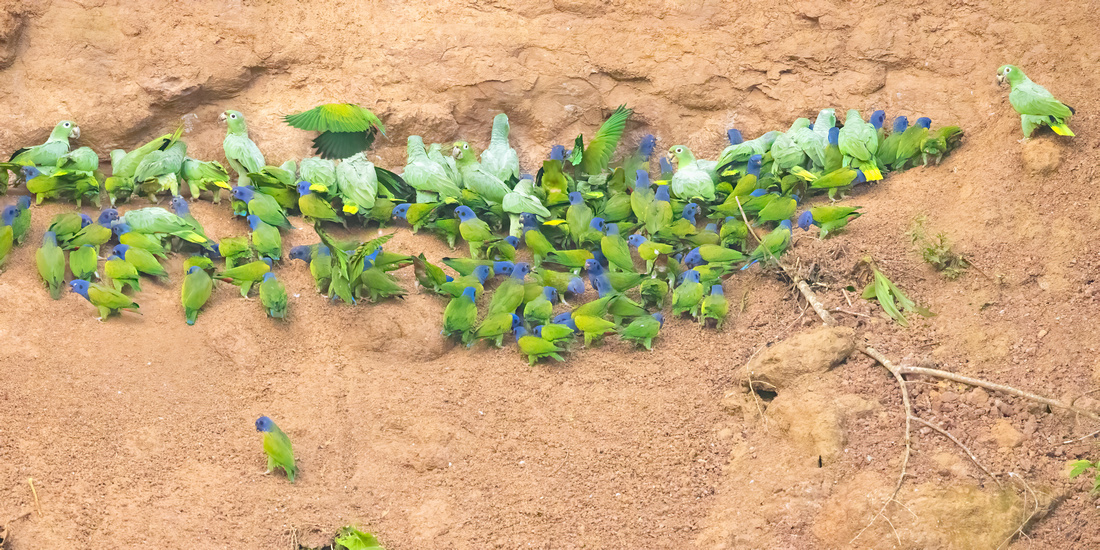
 Anangu Clay Lick
Anangu Clay Lick
We continued upstream and entered the Yasuni National Park. Along the way we spotted a troop of red howler monkeys in the riverside jungle.

 Red Howler Monkey
Red Howler Monkey
We hiked on a very well maintained trail to a large pavilion which served as a blind for observing a small dark mineral spring. This spring is used daily by scarlet macaws. After two hours we had only seen a few speckled chachalaca.
The macaws had been noisily calling all morning nearby and finally began to decend to the pool in large numbers. Singly they are impressive birds, but in large numbers they are spectacular.

 Scarlet Macaw
Scarlet Macaw

 Scarlet Macaw
Scarlet Macaw
The pavilion/hide was large enough to accommodate 70 observers. It was nearly full by the time we left. It was about to become even more crowded as we meet a high school field trip of over 40 students hiking in.
We visited the Sani Community where we received cooking lessons and sampled some of the local delicacies. Becky did a little shopping. After lunch we watched as some of our fellow travelers tried their luck with a Sani blowgun. It must take some practice to operate accurately as most attempts were wildly inaccurate.
We cruised a few mid-channel islands after lunch and came across a boldly patterned pied plover, greater yellowlegs, and a southern lapwing.

 Pied Plover
Pied Plover
The guides knew a tree that contained a family of pygmy marmosets. These are the smallest monkeys in the world and pretty difficult to spot in the dark canopy. Maxie spotted one and I managed a few shots of these cute miniature primates.
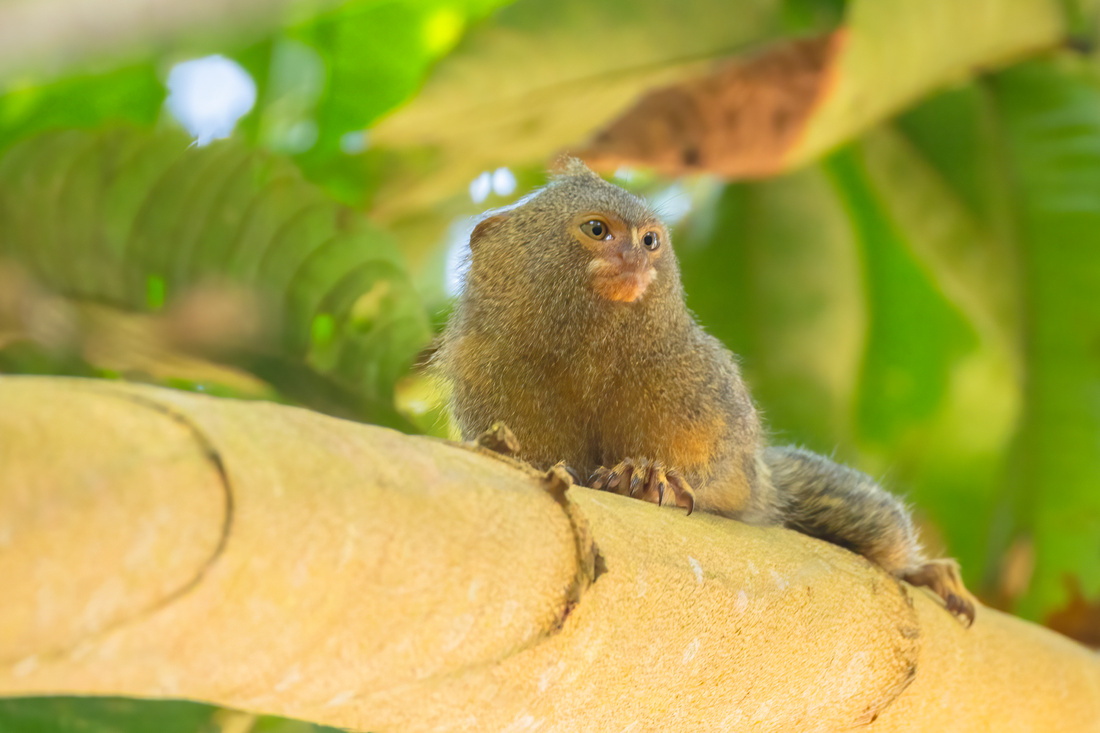
 Pygmy Marmoset
Pygmy Marmoset
In a neighboring tree Maxie also spotted a tropical screech owl.


Tropical Screech Owl
It was hot and very humid. We headed back to the lodge during the heat of the day.
We took a canoe ride in search of marsh birds that evening and located a gray-capped flycatcher, hoatzin, black-capped donocobious, Amazon kingfisher, green kingfisher, ringed kingfisher, magpie tanager, great egret, snowy egret, turkey vulture, and black vulture.
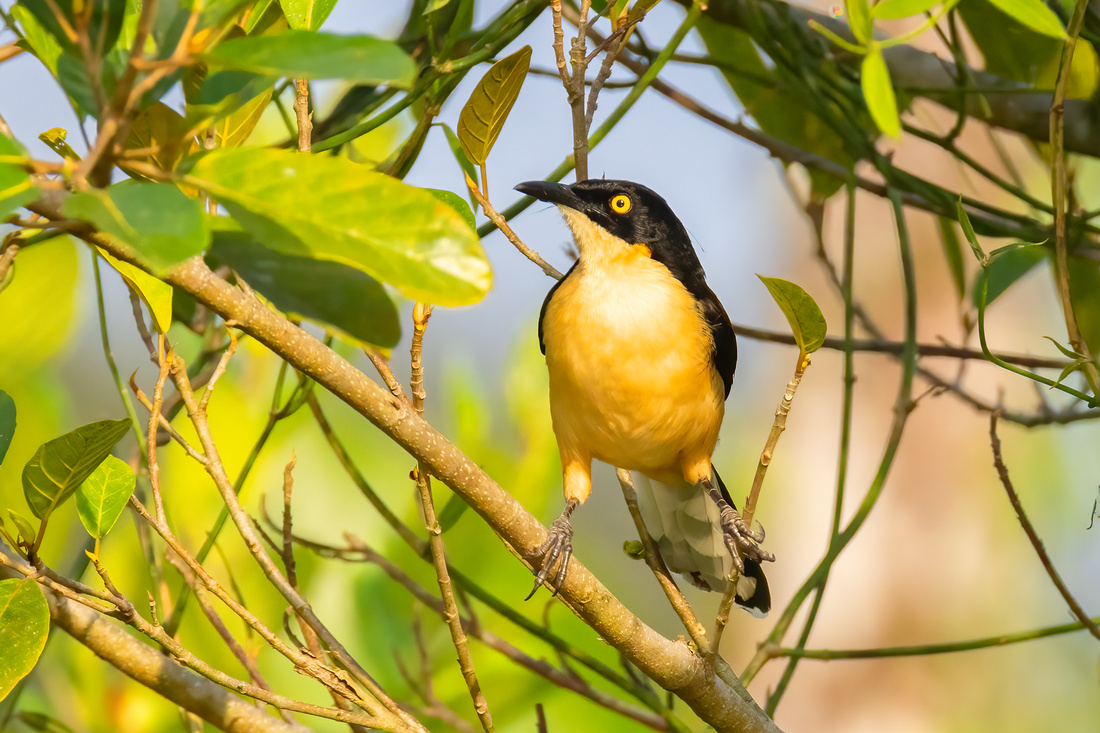
 Black-Capped Donocobious
Black-Capped Donocobious

 Sunset at Sani Lodge
Sunset at Sani Lodge
Early the next morning we canoed to the nearby canopy tower. This tower is 121 foot tall structure inside the canopy of a huge kapok tree. From the top it allowed expansive views of the surrounding jungle canopy and ready access to canopy species difficult to detect from ground level. Carlos had brought his spotting scope and we had some distant looks at bat falcon, king vulture, black-headed parrot, plumbous kite, and gray-headed kite. Small mixed flocks soon appeared which were close and very active. From the tower we photographed purple honeycreeper, squirrel cuckoo, golden-bellied euphonia, sulphur-bellied flycatcher, blue dacnis, opal-crowned tanager, opal-rumped tanager, paradise tanager, white-necked puffbird, many-banded aracari, great potoo, green-and-gold tanager, long-billed woodcreeper, and green honeycreeper.

 Green Honeycreeper
Green Honeycreeper
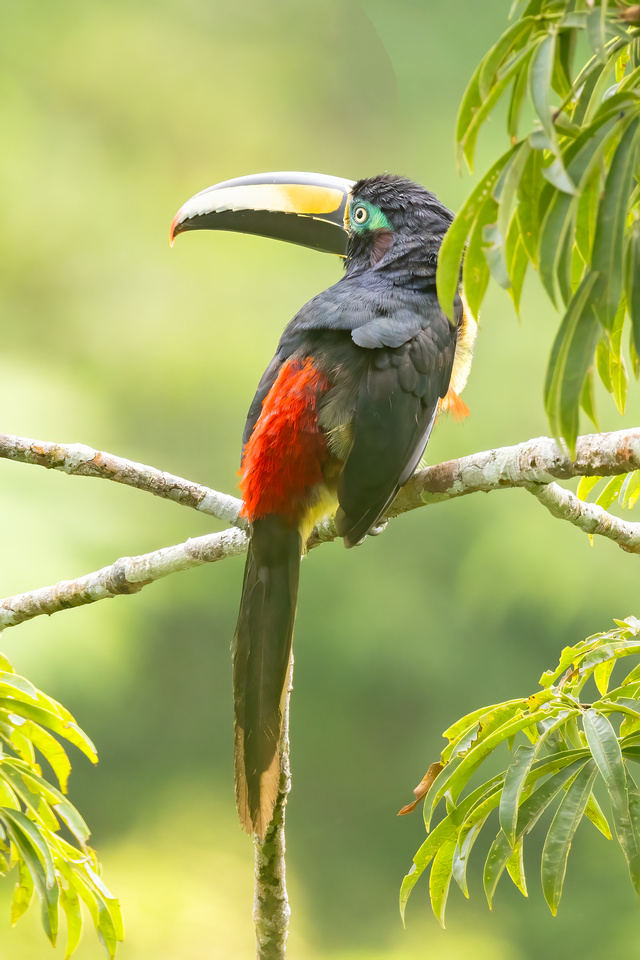

Many-Banded Aracari
Continued in Ecuador 2025 Part 4
Ecuador 2025 Part4
Sani Lodge continued

 Orange-Bellied Euphonia
Orange-Bellied Euphonia


White-Necked Puffbird

 Paradise Tanager
Paradise Tanager


Squirrel Cuckoo

 Purple Honeycreeper
Purple Honeycreeper

 Opal-Crowned Tanager
Opal-Crowned Tanager
Almost directly below the tower were golden-headed and wire-tailed manakin leks. We had no trouble locating a wire-tailed manakin, but the golden-headed eluded us.


Wire-Tailed Manakin
As we paddled back to the lodge we flushed an anhinga and a capped heron. This was our only sighting of either of these species.

 Capped Heron
Capped Heron
After lunch I spent the afternoon looking for new species around the lodge. I was able to photograph coco heron, silver-beaked tanager, greater ani, pale-vented pigeon, magpie tanager, and violaceous jay.

 Violaceous Jay
Violaceous Jay


Cocci Heron


Greater Ani


Pale-Vented Pigeon
On our last evening we picked up very few species. We did photograph a yellow-tufted woodpecker, blue-throated piping guan, black-mantled tamarin, guilded barbet, and wattled jacana.
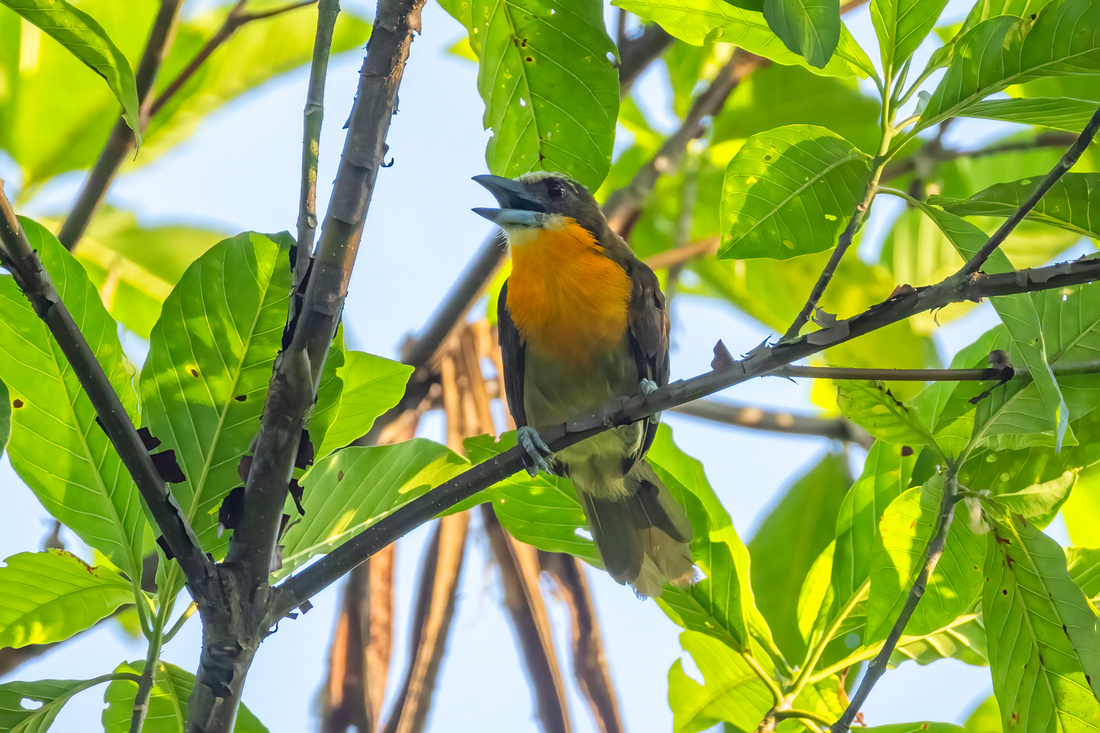
 Guilded Barbet
Guilded Barbet

 Yellow-Tufted Woodpecker
Yellow-Tufted Woodpecker
After it was to dark to shoot, Carlos lead us deep into the jungle to search for the zigzag heron. We did not find them. Do to some miscommunication between our guides we ended up hiking cross-county in the dark back to where we had left the canoes. It was a long, miserable hike. At one point Carlos spooked a tapir which went crashing by. Few places are as dark as the Amazon jungle.
The next morning we had yet another very early departure to return by canoe to the Sani dock. From the dock we would travel by motorboat to Cocoa. The other groups all left with their guides in their canoes. We waited about 15 minutes in the dark for Carlos to appear. When he did not, I rousted the Sani Lodge Manager who was also unable to locate Carlos. He assigned two young men to get us to the river dock. They paddled hard all the way and we arrived before the motorboat departed. After a three hour return boat ride we arrived in Cocoa and were bused to the airport and caught the 30-minute flight back to Quito. We were delighted to see Luis again as he showed up to transport us to our airport hotel and again the next morning when he dropped us off at the Quito airport for our return flight. We traveled from Quito to Miami where we had a three hour layover, then to Atlanta where we barely caught our flight to San Francisco.
I returned home with about 15,000 photographs. I observed 321 bird species on the trip of which 244 were life birds. I was very pleased with these results as well as the quality of the photographs I was able to capture. I highly recommend Luis Panama. He was an excellent guide and travel companion.
All the photographs included in this blog as well as those in the Ecuador album on this website are my own. Nearly all were captured using a Canon R5 camera and a Canon 200-800mm lens. This combo proved quite versatile.
Consider travel to Ecuador. It is a diverse, beautiful country with friendly people and many, many colorful birds.
After so many early mornings and rugged conditions in the Amazon Becky objects when I call the trip a vacation. She insists it was an "experience" and hinted that my future trip planning privileges may be revoked.
East Africa August 2023 - Part Two Tanzania
We next traveled overland, crossing the border into Tanzania. All our visas were complete and we had a smooth border crossing. Lunch in Ashura at a beautiful coffee plantation, then we continued our travels to Burunge Tented Camp near Tarangire National Park. The camp has an elevated dining deck and infinity pool overlooking a small waterhole. Tarangire National Park is considered to have the largest concentration of breeding birds in the world! This location provided great bird photography right off the dining deck.
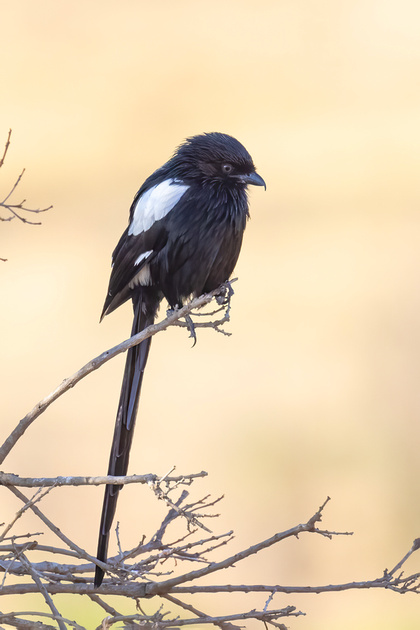

Magpie Shrike
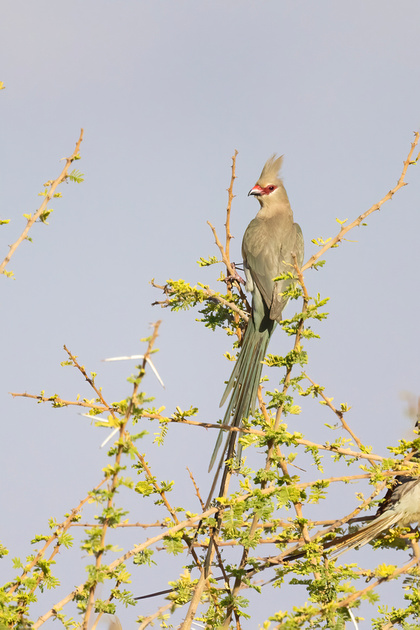

Red-Faced Mousebird


Tawny Eagle
I do not normally have allergies, but I had trouble breathing and slept poorly our first night at this camp. Becky also slept poorly. Through the tent screen she watched an elephant browse a tree within feet of our bed. I slept through it. The night guards confirmed it was an elephant who visited us and mentioned that the tent next to our also had nocturnal prowlers, six lions. After that we slept with out tent securely buttoned up.
African Savanna Elephant
The next morning we embarked on an all day game drive within Tarangire National Park. It was a long, dusty, rough drive to a swampy area with abundant wildlife. We observed vast numbers of African buffalo, and six lions, including one well up in a tree.
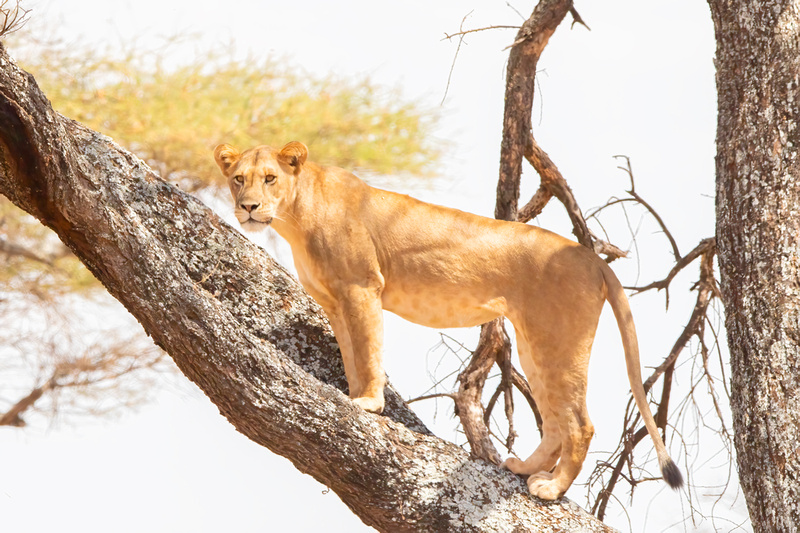

Arboreal Lioness
Elephants were numerous and close, including one whom had been lost from the herd and walked the shoreline trumpeting loudly. We observed a few new species here including, Klipspringer, martial eagle, long-crested eagle, black-faced sandgrouse, Verreaux's eagle-owl, wattled lapwing, red-billed quella, cut-throat, purple grenadier, ashy starling, D'Arnaud's barbet, speckled mousebird, and Von der Decken's hornbill. My allergies got worse and I resorted to wearing a buff to reduce dust inhalation. The group took a short drive to Lake Burungee to view vast concentrations of flamingo. I stayed at the elevated deck and photographed the numerous birds hanging out near the waterhole. I got some nice shots of the very unattractive marabou stork and had six tawny eagles in sight at one time.
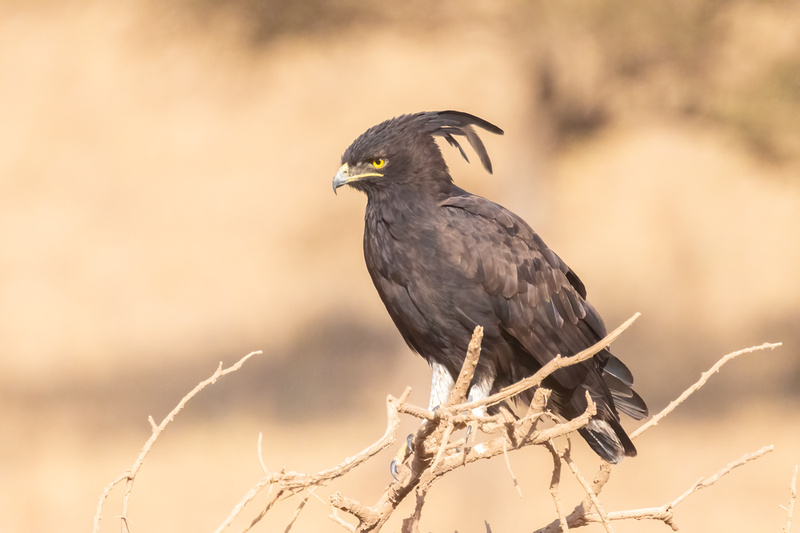

Long-Crested Eagle
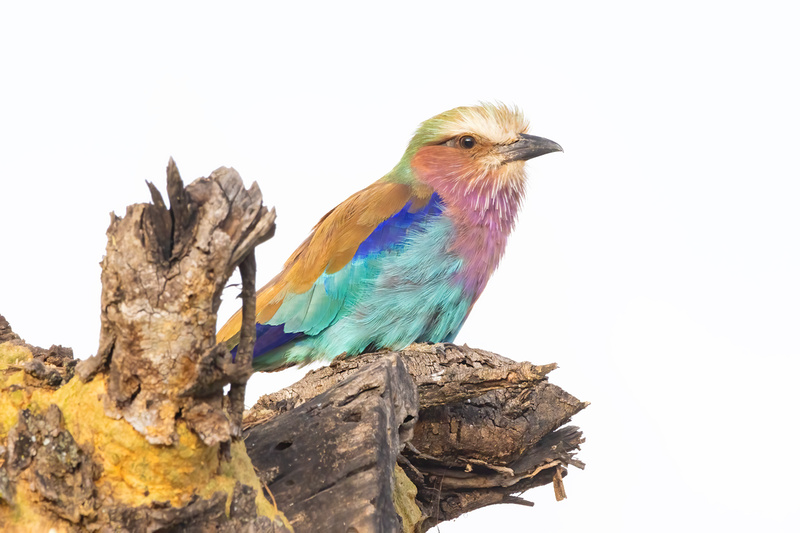

Lilac-Breasted Roller
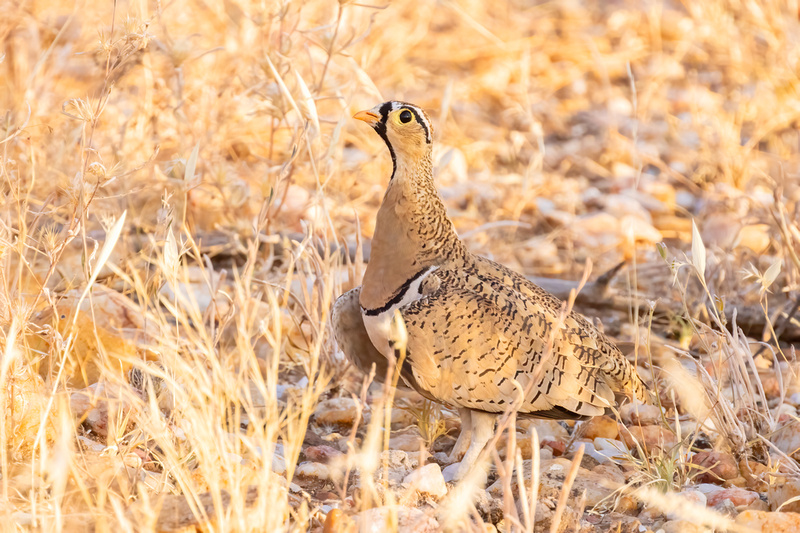

Black-Faced Sandgrouse
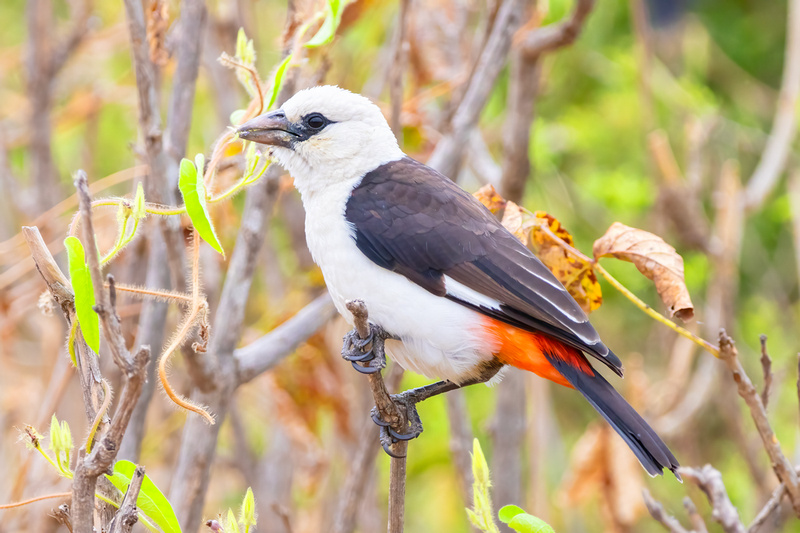

White-Headed Buffalo Weaver
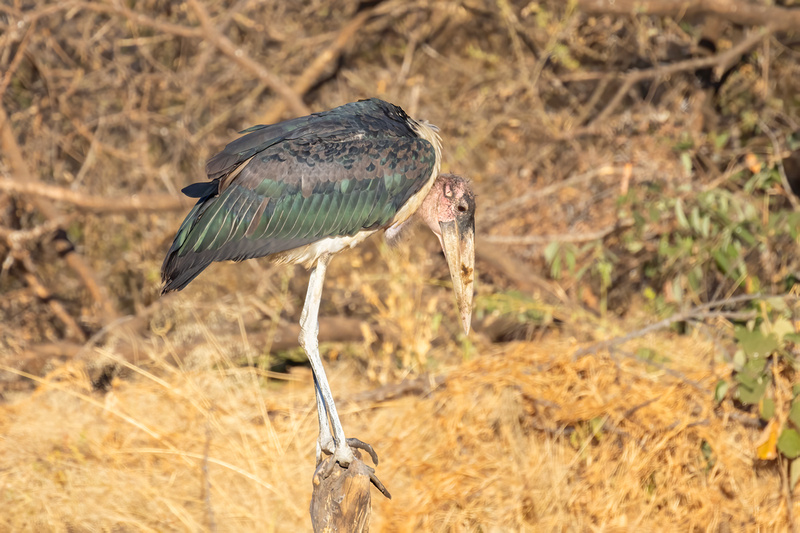

Marabou Stork -Primarily a Scavenger and Labeled as One of the African Ugly Five
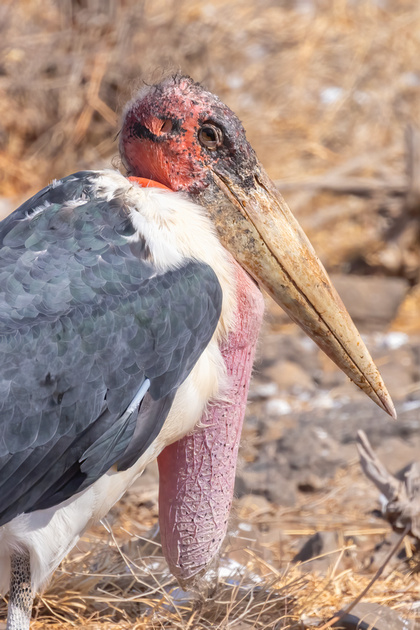

Marabou Stork - Note the Enlarged Gular Sac
The next morning as we enjoyed a sunrise breakfast we were visited by eight elephants as they made use of the waterhole.
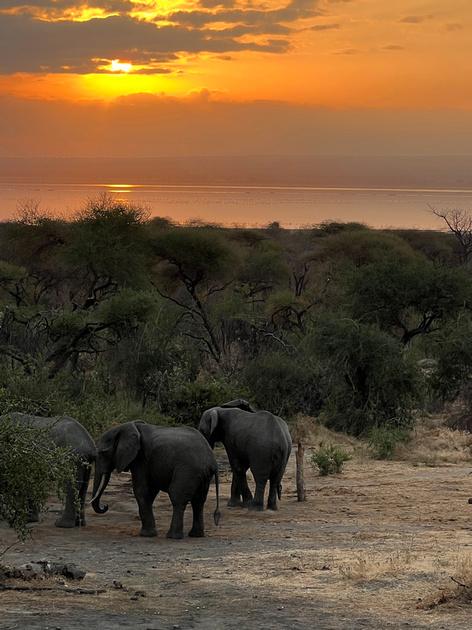

Breakfast Elephants
After breakfast we were on the move again and headed to Tloma Lodge near Karatu. This lodge was beautiful with large, individual bungalows within a shaded coffee plantation. This camp was at the highest elevation of any we visited. Each bungalow was equipped with a gas fireplace. We had some much needed downtime during the afternoon which allowed me to catch up on my photo downloads and backups.
The next morning we headed for Ngorongoro Crater. As we gained elevation we entered a dense, lush rainforest type vegetation where we encountered African savanna elephant and African buffalo at very close range.
We came upon two male giraffe posturing and shuffling. They suddenly began to beat each other by swinging their necks and smashing their heads into their opponent. Then they would take another break to posture and juke before repeating their attacks. Remarkable behavior that I never expected to observe. Very cool. They were still at it with no clear winner when we departed. However, using your head as weapon has some cosmetic consequences.


Masai Giraffe Dominance fight
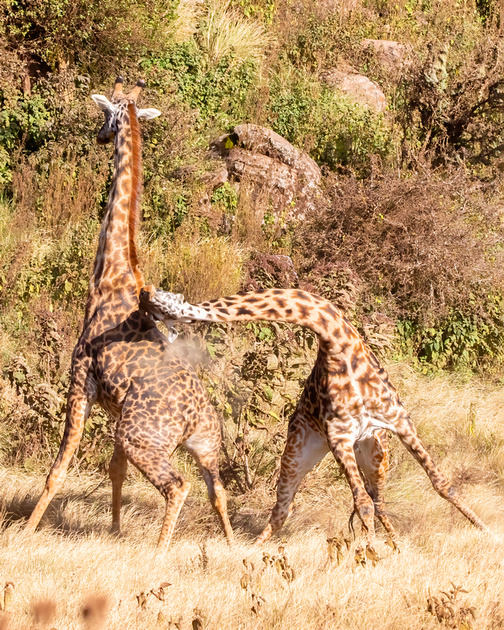

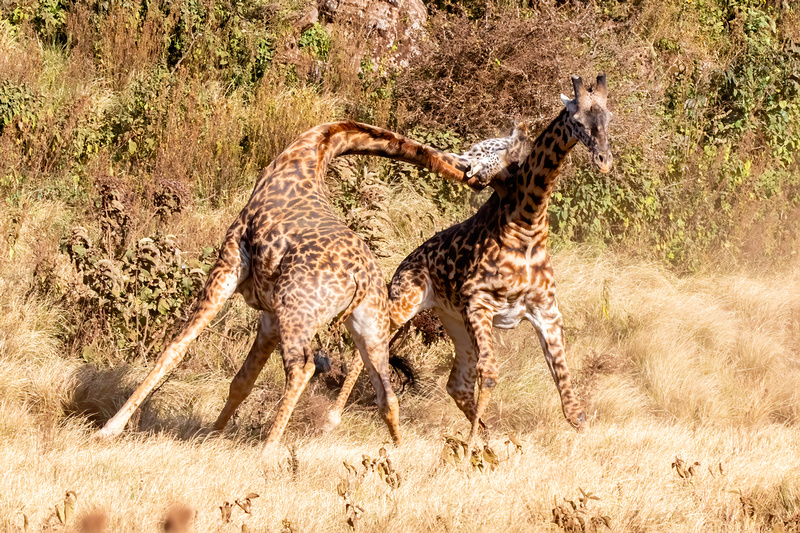

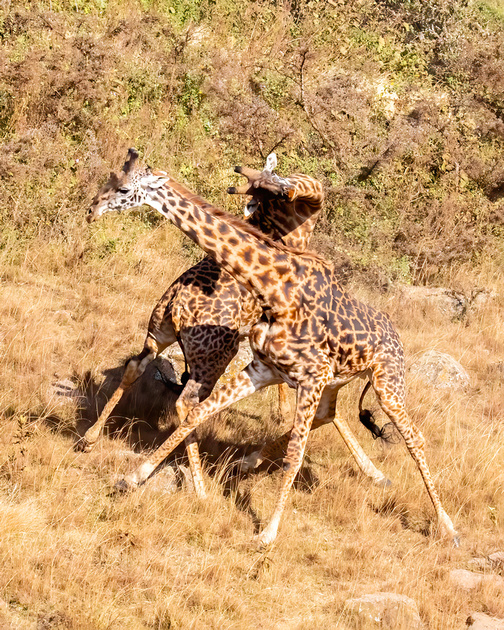

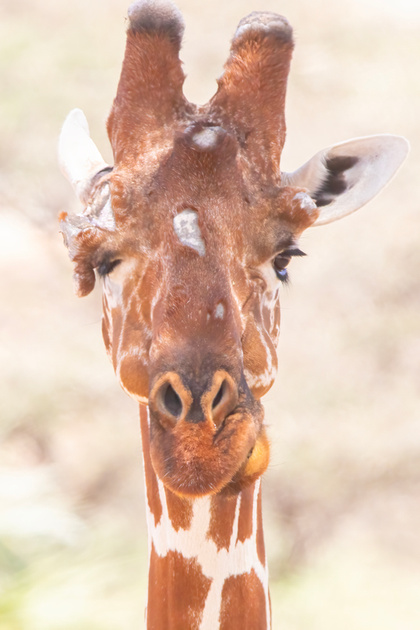

There are Cosmetic Consequences to Using Your Head as Your Principal Weapon
We made a brief stop at the crater overlook. The crater was formed when a volcano collapsed resulting in a 100-square mile relatively flat plain about 2,000 feet below the crater rim. An estimated 25,000 large animals live within the crater and this abundance supports five lion prides.


Ngorongoro Crater
After descending into the crater on a very steep brick road, we entered the crater floor. The diversity and abundance of animals was amazing, quite unlike anything we had seen previously. The crater floor is flat and generally lacks tall vegetation, so visibility is excellent. We came upon a pride of lions snoozing next to the remains of a recent buffalo kill. One woke up and cruised on over to inspect the safari trucks. Nice close looks.
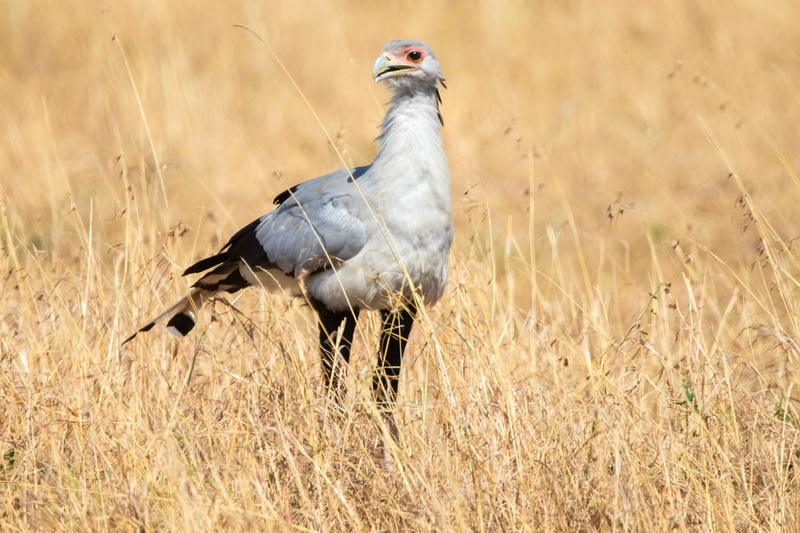

Secretarybird
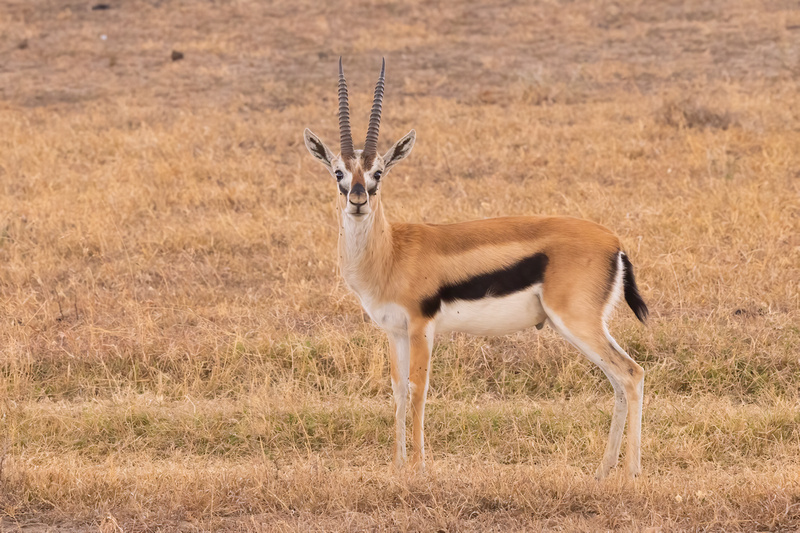

Thompson's Gazelle
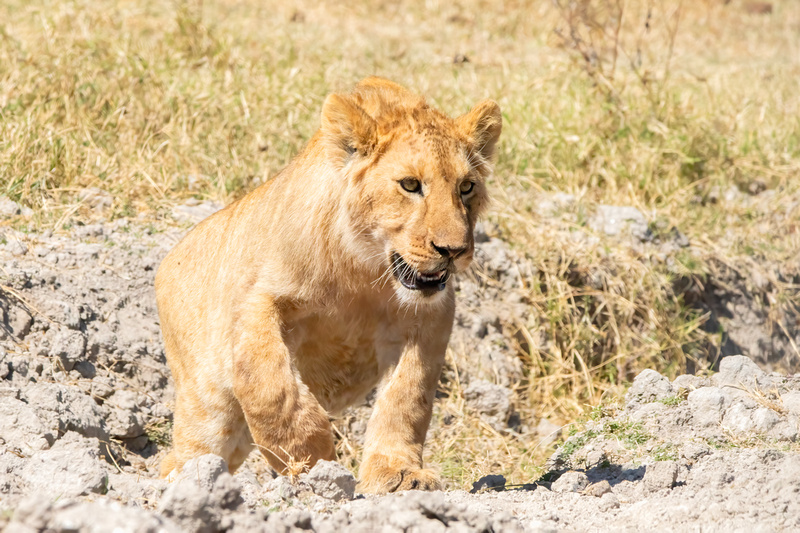

Young Lion Checking out the Safari Truck
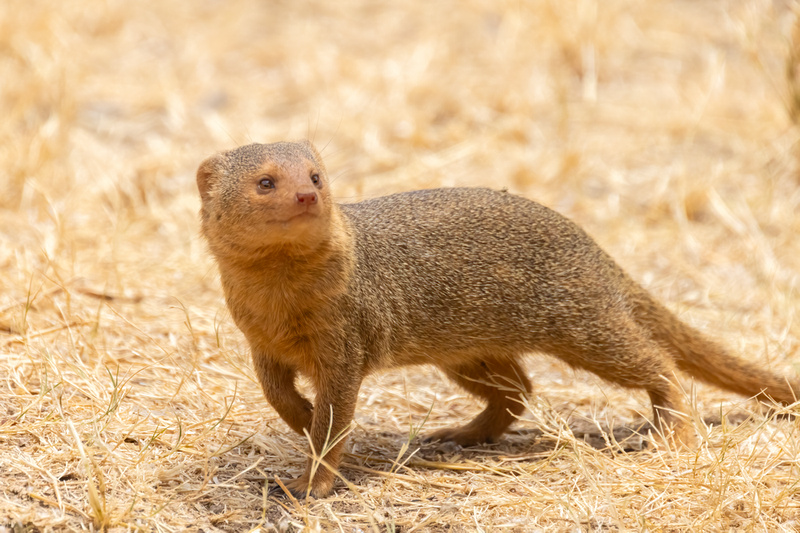

Dwarf Mongoose
Around the next bend we found another lion pride feeding on a very recent zebra kill. Once the large males were done feeding the females moved in and fed. Hyenas and jackals circled at a distance waiting for their opportunity. Off in the distance we saw great clouds of dust as another hunting pride of lions produced a mass stampede of wildebeest and zebra. It was unclear if their hunt was successful. About thirty minutes later we encountered yet another pride of lions on a kill. Thirty-two lions in a morning. When we stopped for lunch at a swampy area we saw fifty of the striking gray-crowned crane in a single group.
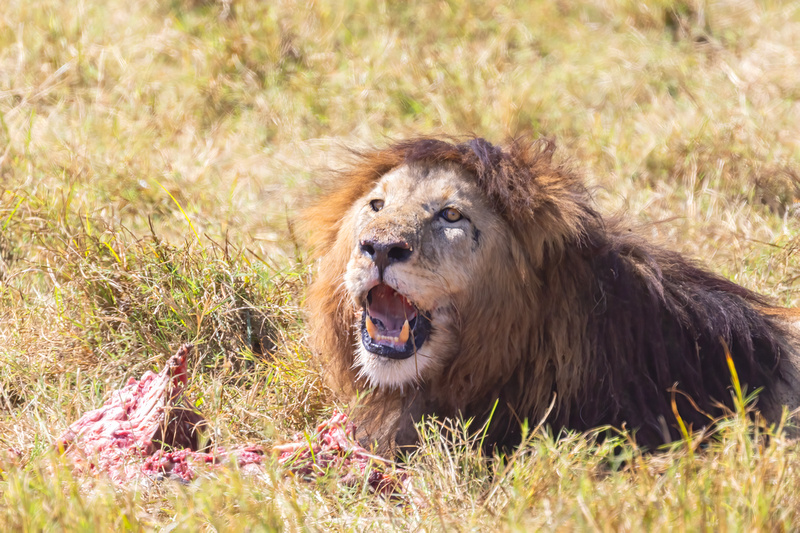

Male lion on a Recent Zebra Kill.
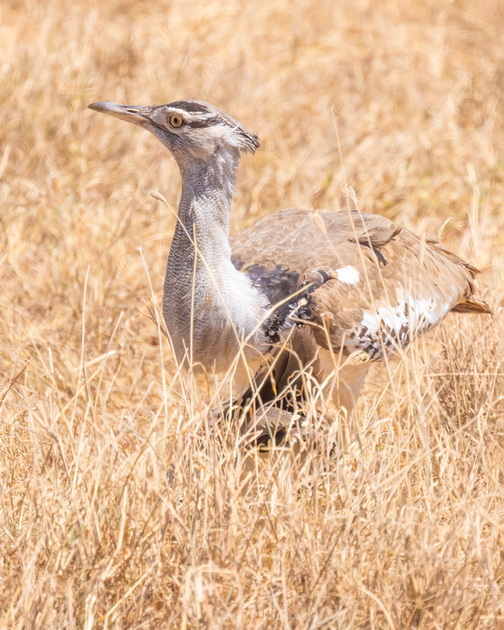

Kori Bustard - Largest African Bird Capable of Flight with Reported Weights up to 40 Pounds
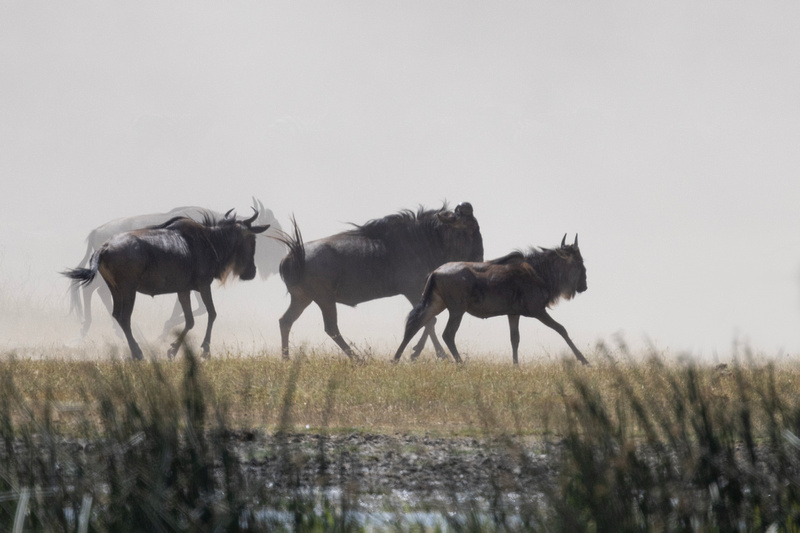

Wildebeest Stampede
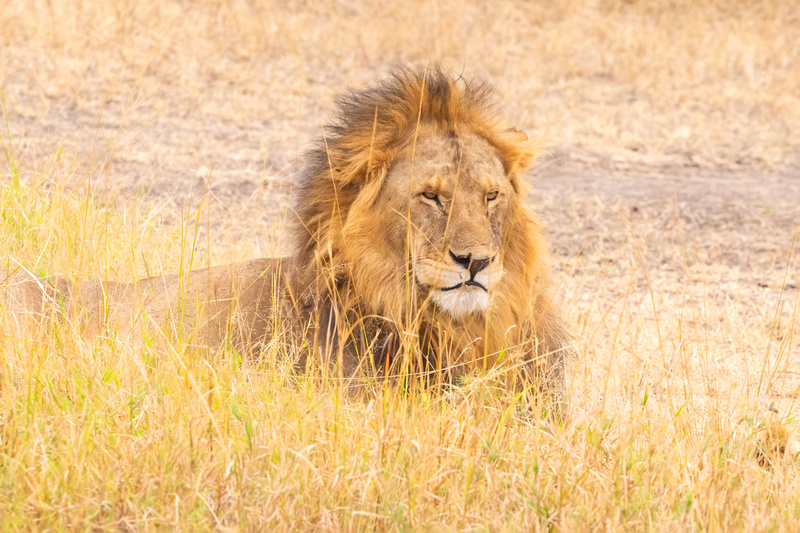

Large Male Lion at our Third Pride of the Day.
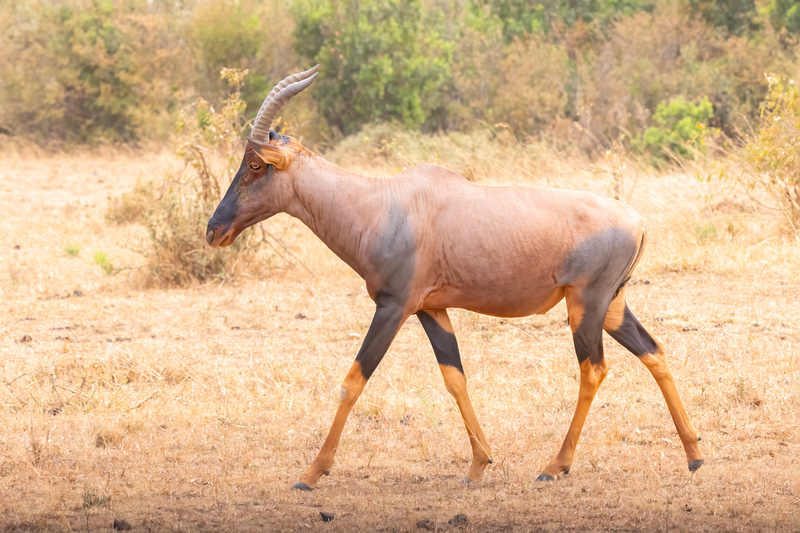

Topi - Blue Jean Antelope
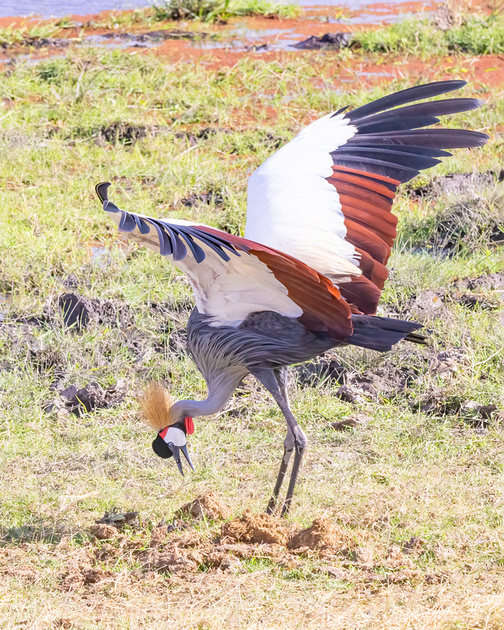

Displaying Gray-Crowned Crane
The next morning we headed to Lake Eyasi, home of the Hadzabe (Bushman). The visit was probably worth a blog on its own. Very interesting and friendly people. They live a very primitive, hunter/gatherer existence and communicate in an odd clicking language which our Datoga guide was able to translate. The bushman trade with the nearby Datoga tribe who are skilled blacksmiths and provide the Bushman with arrowheads fashioned from large nails. We followed our Datoga guide to the Bushman's current camp and in exchange for a handful of finely crafted arrowheads we were welcomed to the camp. The entire tribe sheltered inside a single hollow baobab tree. The wore a mixture of animal hides and modern clothing.
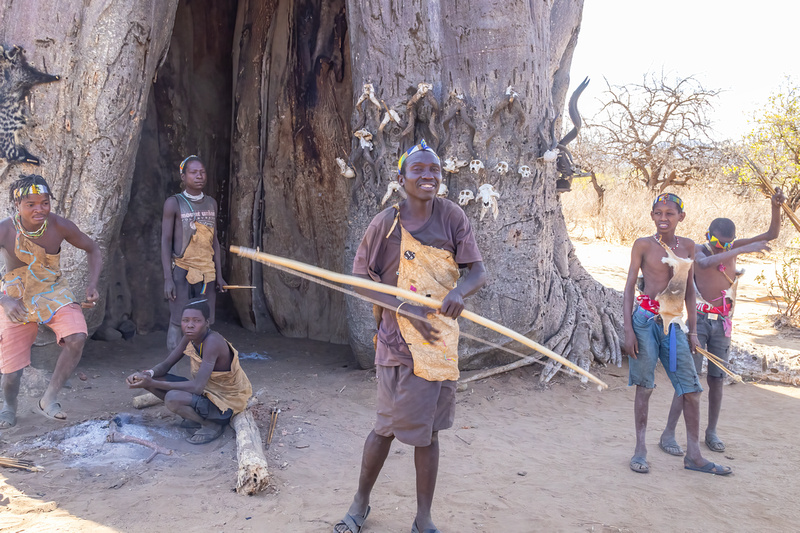

Hadzabe Encampment


Hadzabe Hunter
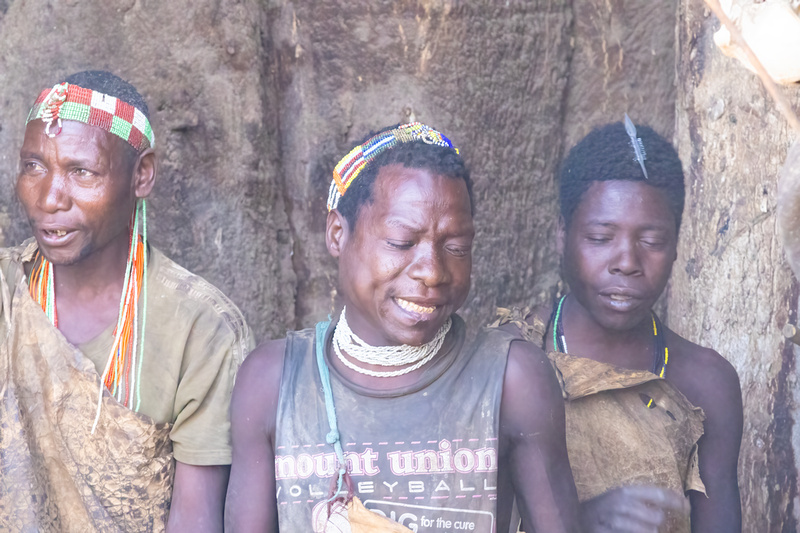

Hadzabe Singers - Note the Baboon Arrowhead in the Hair of the Singer on the Right of the Frame
Each morning the men depart with their bow and arrows and hunt the country for up to 10 miles around. The women, armed with pointed digging sticks collect edible plants and the odd rodent or snake. Every day is a new search for protein. We followed as a woman dug up a small mouse and the men killed a small sunbird with their bows. They quickly started a fire using two pieces of wood and cooked both prey items whole. The offered us the choicer morsels. Becky, oddly was not hungry. They gave the snacks to the children who happily consumed them.
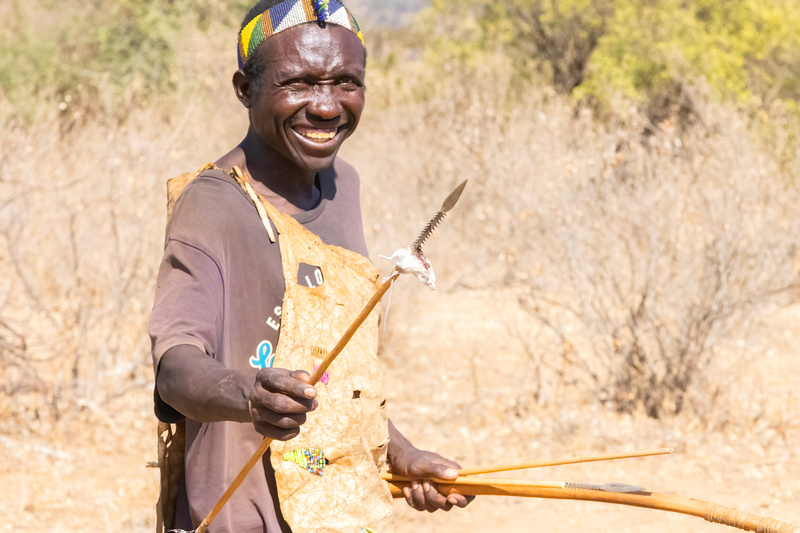

Mouse Snack


Becky in the Bushman Trophy Room
They kept trophies tacked to the side of the baobab tree including several baboon skulls. Baboon brains are considered a delicacy and they use a special back-barbed arrowhead to hunt them. The barbs prevent the punctured baboons from pulling the arrow out. They use a variety of arrows, including poisoned ones for larger game. They urged me to try one of their bows and I was unable to pull it to full draw. They claim kills out to 200 yards using these bows.
We briefly visited a Datoga homestead where several skilled blacksmiths were using rather primitive tools in their work. We watched at they took a large nail and fashioned it into a baboon arrowhead. They added intricate designs to copper and brass jewelry which was smelted on a home-made forge. We met the headman of the village and his five wives.


Datoga Blacksmiths at Work - Note the Homemade Bellows.
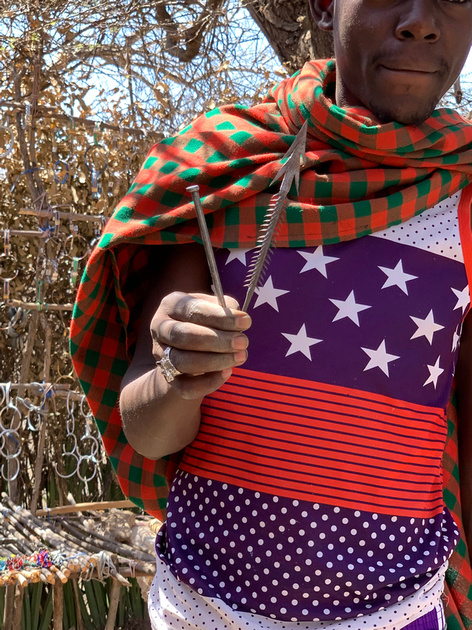

Datoga Crafted Baboon Arrowhead Made from a Large Nail
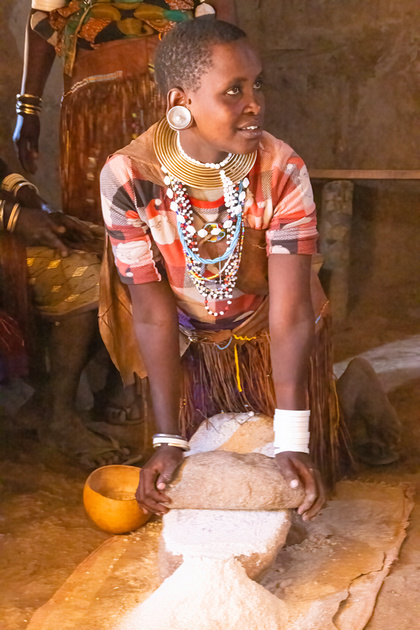

Datoga Woman Grinding Millet
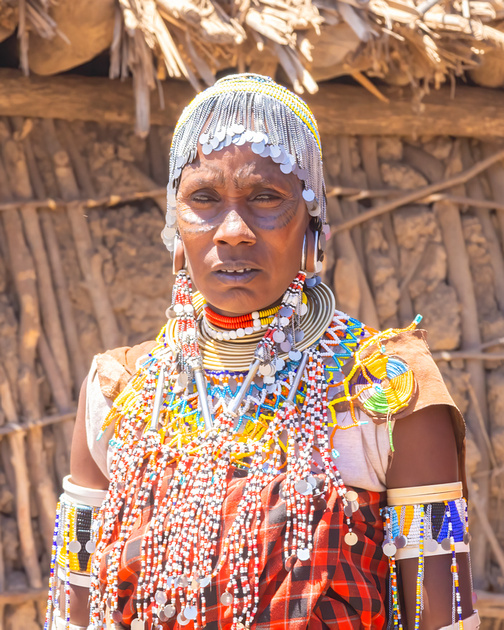

One of the Datoga Headman's Five Wives
Early the next morning we departed Tloma Lodge and crossed through the Ngorongoro Conservation Area and descended into Serengeti Nation Park. As we descended from the crater highlands the landscape began to change. It was an extremely desolate, windy, and dusty passage. We made a quick stop at the head of Olduvai Gorge. This is the location where anthropologists Mary and Louis Leaky unearthed one of our earliest ancestors. Shortly before entering Serengeti National Park, I photographed what I believe is an African wolf. They are very rare and difficult species to observe.


African Wolf
Serengeti means endless plain in Swahili. It fits. The Serengeti is about 5,700 square miles of savanna grassland with lesser amounts of acacia woodland and riverine brush habitats. It quickly became our favorite location of the trip. We spotted a pair of cheetah resting on a termite mound near a recent kill. They moved off as a young male lion checked out the remains of their kill. We followed the young male lion as he moved toward a stream occupied by a large lion pride. The lioness were on high alert and watched his every move until he disappeared. On the way to camp we spotted a large leopard lounging in a tree. Lots of cats.


Young Male Lion
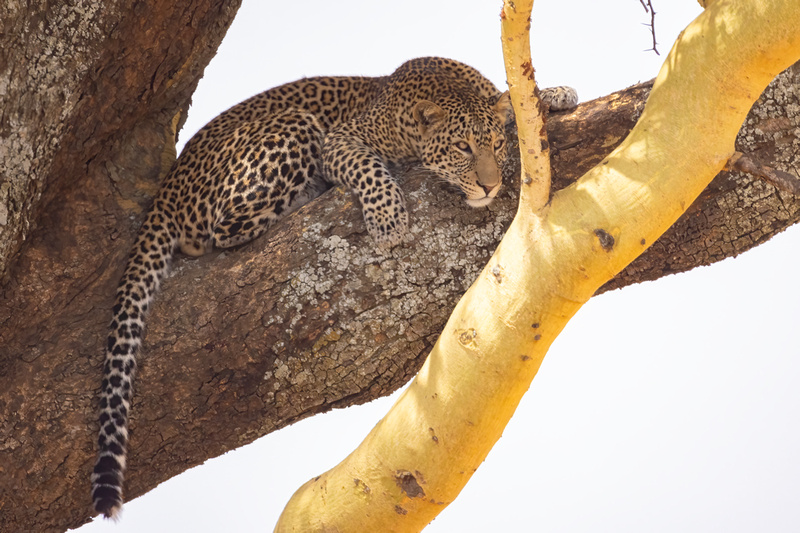

Leopard Lounging the Afternoon Away
Our Serengeti camp was a temporary tent camp that OAT moves to follow the game. The tents were new and the staff and service were excellent. The camp differed from others in that hot water for showers was delivered by hand to a bucket behind each tent. The bucket was raised via a pulley to produce a gravity feed shower. The attendant waited patiently to determine if more than one bucket was needed.
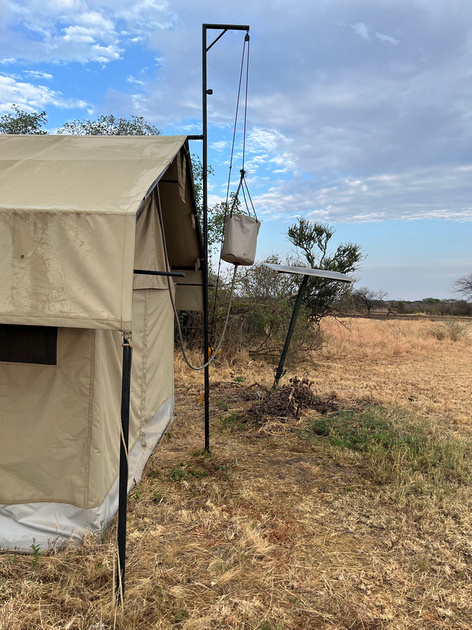

Serengeti Camp Shower Arrangement
We spent four nights in this camp and enjoyed so many lion sightings on our game drives. I ended up with 108 lions for the trip, most in Tanzania. We watched two successful lion hunts and several unsuccessful ones. One lioness managed to snag a Thompson's gazelle out of midair as it tried unsuccessfully to avoid her.
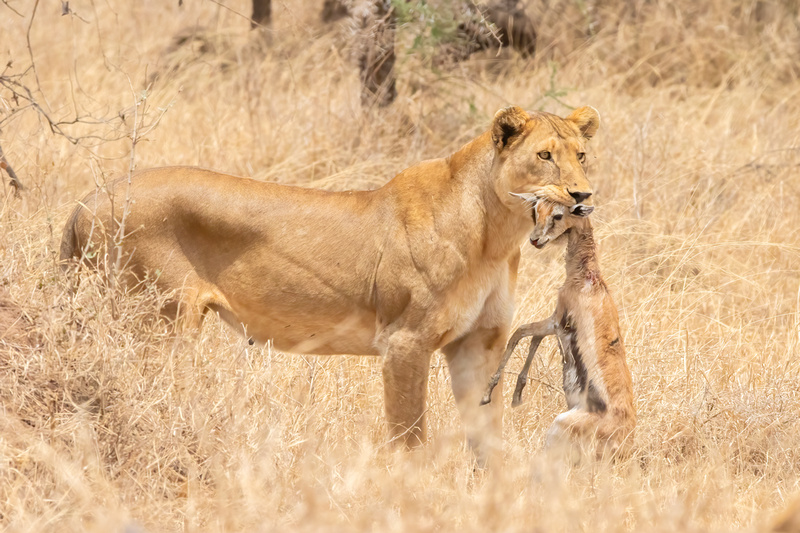

Lioness with a Thompson's Gazelle Kill
She quickly took her prey down near the stream to keep it out of sight. She was unsuccessful as a large male lion charged in and took her kill. He only enjoyed his stolen meal for a minute when two additional male lions rushed in and created a dusty scrum as they fought for a piece of the small antelope.
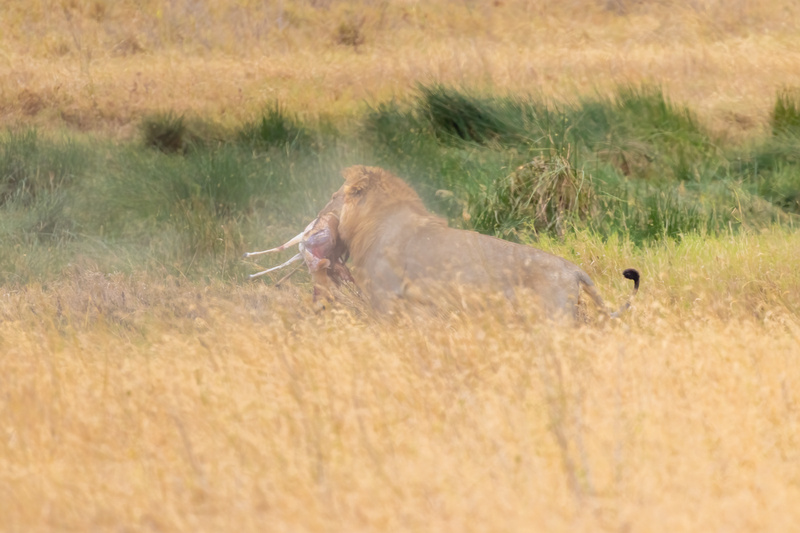

Once the Dust Settled This Large Male Ended Up With the Biggest Piece
Other interesting wildlife behavior involved hyena and lion interactions at a recent lion killed buffalo carcass. We found the carcass after observing a lioness with a very distended belly. As she moved away from the carcass the hyenas began to move in. When another single lioness returned to feed the hyenas brazenly dashed in and made off with a foreleg. When a second lioness joined the first, the hyenas became more circumspect and retreated to a safe distance. Such cool interspecific interactions.
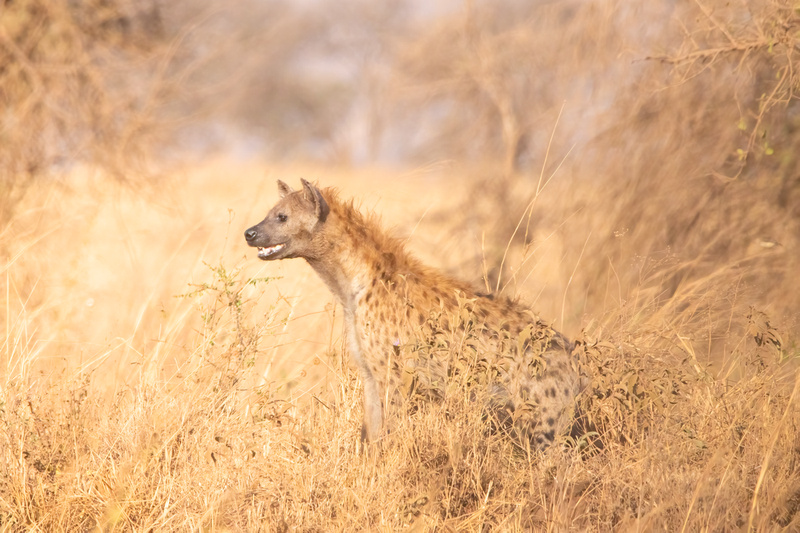

Spotted Hyena Circling a Recent Lion Kill
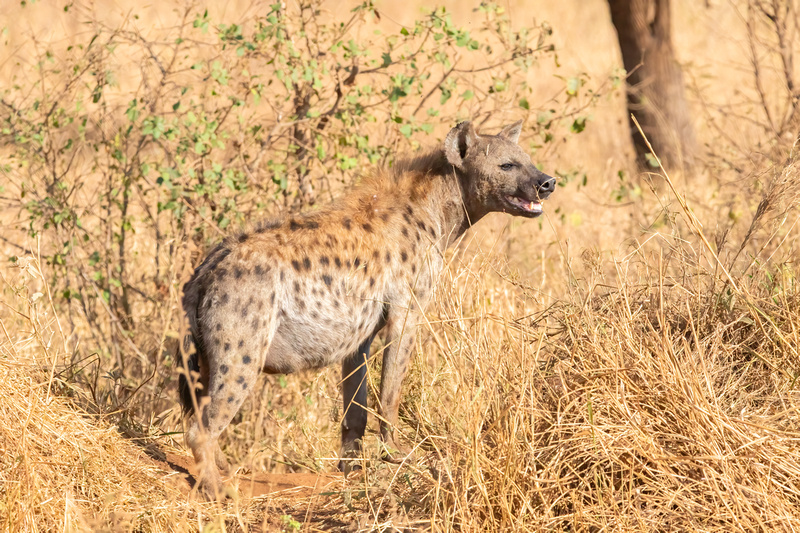

Spotted Hyena - Note the Distended Belly
On one of our all-day game drives we chanced upon a serval in tall grass. We had a few quick looks and then he disappeared. We were lucky to spot one as the guides indicated it was the first one that they had seen in three months. That same afternoon we had a mock elephant charge and had some nice looks at a distant leopard on one of the rock outcrops (locally called kopjes).
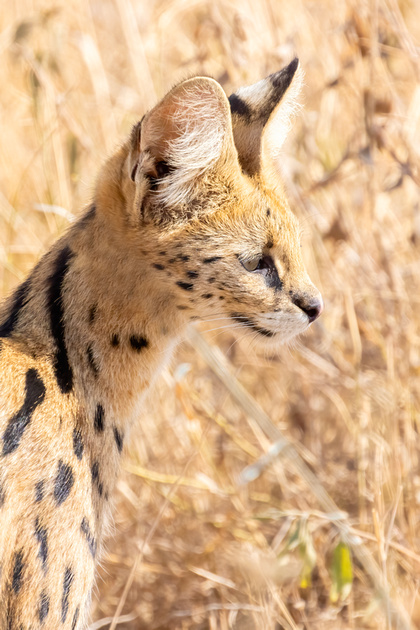

Serval
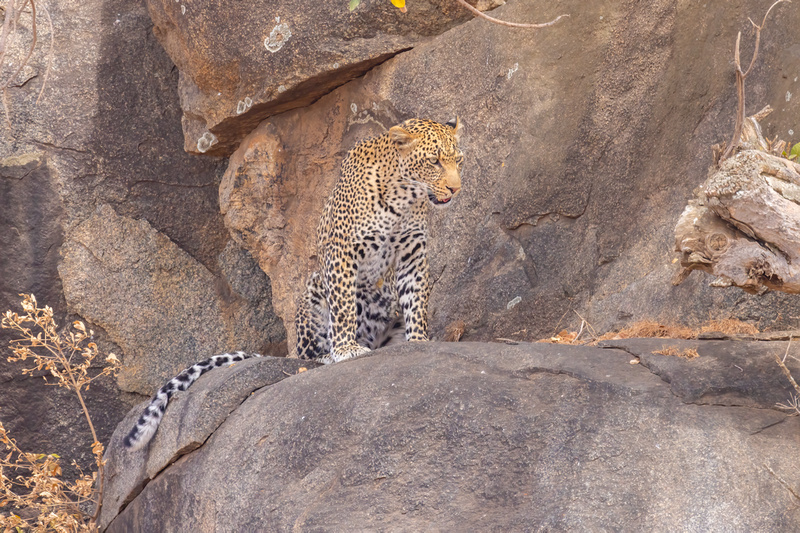

Leopard on a Kopjes
The next morning we dashed to a reported cheetah sighting. It turned out to be an adult female and five half-grown young. The female watched for predators as the young finished off a recently killed gazelle. Beautiful cats. Pretty amazing that she had been able to feed and protect the cubs in such a predator rich environment.
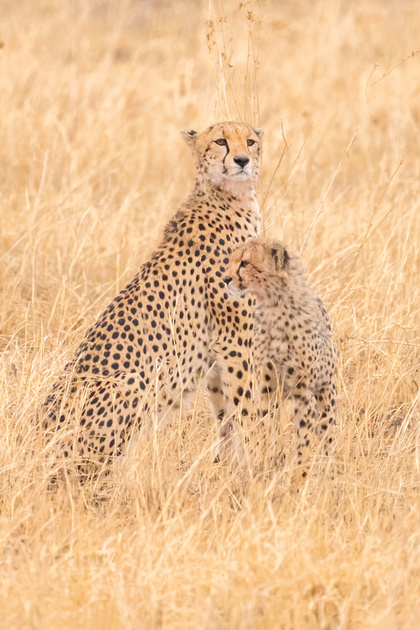

Female Cheetah with One of Five Cubs


Young Cheetah Practicing his Takedown Moves on Mom
Shortly after leaving the cheetahs we spotted a leopard asleep in a tree. Before his nap he had packed a lunch. A Thompson's gazelle was placed on a fork in the tree next to the sleeping cat.


Leopard with Gazelle.
We continued to find lions every day whenever we were near water. The lions knew that the prey had to have water and staked out prime drinking spots. We found a collared lion with very young cubs. The guides indicated that the cubs were probably less than two weeks old. At one point we had a pride of 14 lions surrounding the trucks. Quite an adventure.


Very Young Lion Cub


Surrounded by Lions


Hunting Lioness


Successful Lion Hunt


Lioness on the Move
We had been advised by OAT that we were limited to a total 33 pounds each. Becky and I packed and repacked attempting to get all of our luggage under 33 pounds. My downsized photo gear weighed 18 pounds, so I wore the same cloths a lot. We were fortunate that most camps provided laundry service. We were later told that limit was only for the flight from the Serengeti back to Ashura and did not include backpack weight. However, no bags were weighed for that flight including some very large suitcases. Frustrating!
After our flight back to Ashura we checked into an upscale hotel (Kimbo Palace) and were provided with a hotel room for the day. That afternoon we were transported to the airport to begin our journey home. Becky and I had elected a three-day stopover in Amsterdam on our way home.
This was an exceptional tour which greatly surpassed my expectations. All of the OAT staff were excellent and really seemed to enjoy their work. OAT travelers are almost exclusively American. OAT specializes in small group travel, advertising maximum group size of sixteen or less. OAT also does not charge a single supplement. We had a total of ten in our group ranging in age from 60 to 80 years of age. A good group.
I used two cameras, a Canon 7D2 and a Canon R5 mirrorless for almost all the photos in this blog and in the East Africa folder on this website. I used two lenses, a Sigma 150-600mm zoom and an 800mm F11 fixed. This proved to be an effective combination. We were frequently so close that the ability to zoom was needed and the 800 gave me the reach to capture small or distant subjects. I ended up with just under 15,000 images.
I used the Merlin app exclusively for bird identification and Stuart's African Mammals app for mammal identification. I was fortunate that two of our fellow travelers were avid birders, so between Ken and Clara and the guides, I believe that most of my bird identifications are accurate.
I highly recommend this OAT Adventure.
